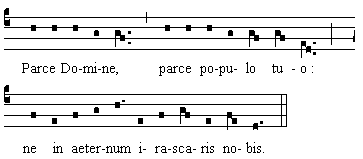

 Overview of the Group
Overview of the Group
The Gregorian Schola of St.
Joseph Parish was founded by Br. Christian
Guertin, FFSC in 1993 as both a performing group and a study
group dedicated to the cultivation, study, and promotion of Gregorian chant as
a musical art. Performances are frequently, but not exclusively, in the
context of a Catholic mass.
The Schola studies the notation and history of Gregorian chant. It chants
in Latin from the "square note" neum notation in the
Gregorian Missal and other sources.
Return to the top of the page.
 Performances
Performances
The Gregorian Schola is based at St.
Joseph Catholic Church of Fayetteville,
Arkansas. It sings primarily at the Saturday 5 p.m. anticipatory mass, where it
is the regular choir, and on feast days. The Schola sings a selection of the
"propers" of the day and leads the congregation in the singing of some of the
"ordinary" (e.g., "Sanctus," and "Agnus Dei").
When it sings at mass
it provides a sheet of the Latin texts of the chants with translations for
prayer and meditation by the congregation.
The Schola (or a subset of its membership) has also performed at
St. Paul's Episcopal Church, the University of Arkansas, some other area
churches, and the Fayetteville Square. In March of 2007 it performed at
the Rogers Public
Library. In December of 2007 it performed at First Night in
Fayetteville.
These links indicate times, dates, liturgical days, and
which chants were sung.
Return to the top of the page.
 Leadership and Membership
Leadership and Membership
The Schola was founded by Brother Christian Guertin, FFSC in 1993. The
current director (since 1996) is Richard Lee, who
has also been cantor since the inception of the group. Prof. Lee
previously sang chant under Prof. William Mahrt at St. Ann Chapel in Palo Alto,
California.
The current membership of the Gregorian Schola
includes men and women, mostly, but not exclusively, Roman Catholic. The
group has included atheists, protestants, Jews, and Franciscan Brothers, but
consists primarily of Catholic lay people. Most members are American, but it
has members from Europe and Africa.
Return to the top of the page.
 What Chant Is
What Chant Is
"Gregorian Chant" refers to the vast corpus of religious music amounting to
some three thousand compositions traditionally named after Pope Gregory I
(reigned 590-604). He has been credited with the development and codification
of the Roman Catholic plainsong.
For more information see the list of chant
resources.
The Schola takes its name from the inspiration of Pope Gregory I, who founded
choir schools and scholas to foster the art of chant throughout Europe. Weekly
sessions usually conducted at St.
Joseph Catholic Church, Fayetteville, Arkansas, seek
to discover the unique artistic, spiritual and theological qualities of
Gregorian music.
More on Why chant is
called "Gregorian"
What chant Sounds like
Return to the top of the page.
 The Place of Chant in the Catholic Church
The Place of Chant in the Catholic Church
Gregorian chant was for centuries the music of the Roman Catholic
Church. While Christian chanting developed from Hebrew chants, Gregorian
chant, as we know it today, is the most notable contribution of the Catholic
church to the musical tradition of the west. There was significant development
over the centuries, but the chants we sing today were probably also sung a
thousand years ago. During the 1960s chant fell out of favor, but there has
since been a resurgence: Witness the best-selling CD "Chant." Chant is an
important part of the history and tradition of the Catholic Church.
Gregorian chant belongs in the Catholic liturgy today. The Vatican II document,
Sacrosanctum
Concilium states that "the Church acknowledges Gregorian chant as
specially suited to the Roman liturgy; therefore, other things being equal, it
should be given pride of place in liturgical services." (sec. 116).
Return to the top of the page.
 Singing Chant
Singing Chant
The Gregorian Schola chants in Latin from the "square note" neum notation in
the Gregorian Missal and other sources.
It sings a capella (that is, without accompaniment by organ or other instruments)
in unison. While Latin and the notation take some getting used to, singers
manage to pick these up quickly. We review the Latin words to help with
pronunciation and most chants we sing are supplied with translations. Modern
musical notation grew out of the Gregorian neum notation and the similarities
ease the learning. The fact that we all sing the same notes at the same time
(unlike part singing (soprano, alto, tenor, bass)) helps each of us sing the
right notes. On most chants the cantors (two or three singers) intone the
chant, that is they sing the first several notes alone, so that by the time the
rest of the choir joins in they have a sense of how the piece goes.
Samples of square note neum notation
available on the net
Return to the top of the page.
 Invitation to Join
Invitation to Join
Anyone interested in joining the Schola may learn more by contacting Richard Lee at DrChant@hotmail.com.
New members are always welcome.
Return to the top of the page.
 Local Links
Local Links
Return to the top of the page.
See also the
 page, which includes dozens of links
concerning Gregorian chant.
page, which includes dozens of links
concerning Gregorian chant.
"These materials are not endorsed, approved, sponsored, or
provided or on behalf of the University of Arkansas, Fayetteville."
Richard Lee,
rlee@uark.edu,
last modified: 29 April 2014
